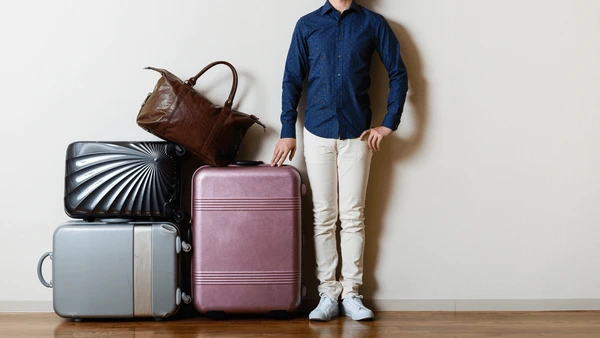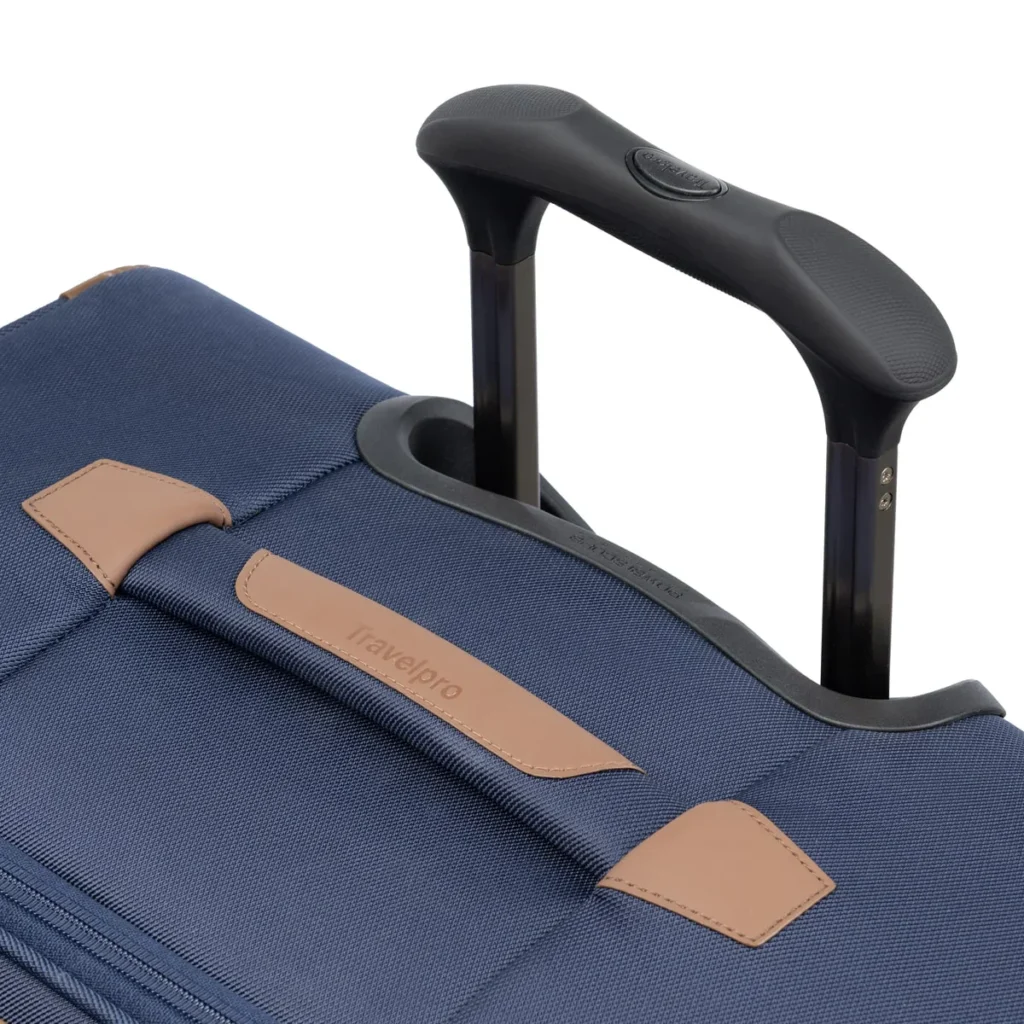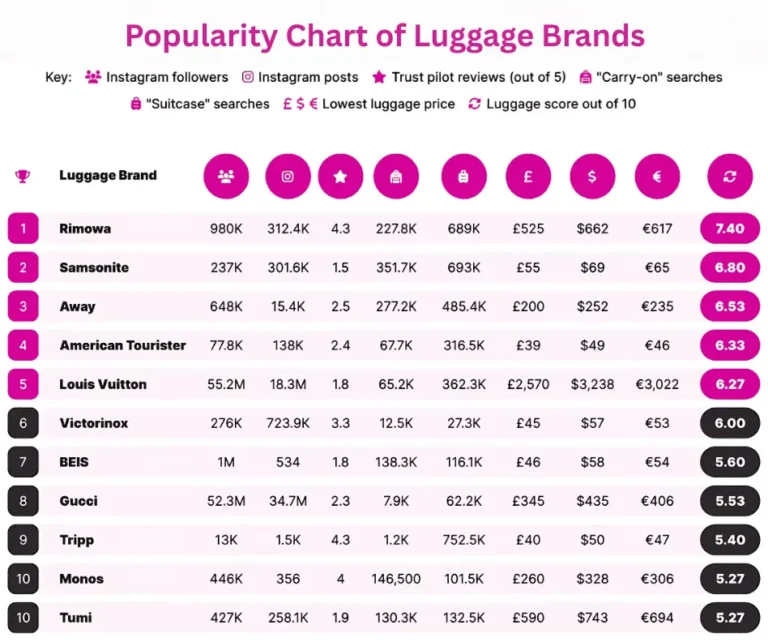Choosing the right luggage is a crucial step before any trip. In my experience as a frequent traveler, the size, material, and features of a suitcase can make or break your journey. A good suitcase should be durable enough to survive baggage handling, light enough to carry, and just the right size for your needs.
In this guide I’ll tell you everything I look for when selecting luggage, from carry-on restrictions to international travel quirks, and even what’s popular in the USA and UK. I’ve drawn on my own travel experiences and expert sources to give you actionable advice on how to choose luggage for your next adventure.
Understand Your Travel Needs:
Before buying a suitcase, I always start by asking myself: How will I use this luggage? My travel style, and yours, can vary greatly:
- Students: Often travel light or on a budget. A sturdy, affordable carry-on or medium checked bag usually suffices. I’d opt for a lightweight, soft-sided carry-on with expandable pockets for flexibility.
- Travel Vloggers/Photographers: Carrying extra gear means I need a rugged bag with compartments. A durable backpack or hard-shell trolley that fits camera equipment and laptop is ideal. I look for padded pockets and excellent wheelability (so my equipment isn’t jostled).
- Frequent Flyers: I rely on luggage with exceptional durability and smooth wheels. Since I see my bag being used constantly, I prioritize strong handles and spinner wheels that roll effortlessly. Consumer Reports notes that for heavy use, durability is key, bags with split seams, broken wheels or handles often end up discarded. That’s why I’m willing to invest in brands known for toughness (more on brands below).
- Business Travelers: I need a professional look plus organization. My suitcase should have a laptop compartment and garment folder to keep suits wrinkle-free. Features like a checkpoint-friendly laptop sleeve make airport lines faster.
In short, match your bag to the type of traveler and trip. I always make a list of what I pack regularly, my mode of travel (plane vs. car vs. train), and whether I prioritize style or utility. This helps me narrow choices before comparing models.

Types of Luggage:
Once you know your needs, consider what type of luggage suits you:
- Carry-On vs. Checked Suitcases: Carry-ons (usually under 45 linear inches total: e.g. 22″×14″×9″) fit in airplane overhead bins. They’re great for short trips or avoiding baggage fees. Checked bags (24″-30″+) carry more but can incur fees and risk of rough handling. I often use a carry-on (usually a 40-50 L bag) for week-long trips if I pack light.
- Hard-Sided vs. Soft-Sided: Hard-shell suitcases (polycarbonate, ABS or aluminum) give excellent protection against impact, but can be heavier and show scratches. Soft-sided bags (nylon, polyester or canvas) are lighter and can expand to fit more. Personally, I choose hard-shell luggage when flying internationally with fragile items, and soft-sided luggage for domestic trips where I might squeeze the bag into tight spaces.
- Duffel Bags & Backpacks: For casual or adventure travel I sometimes go with a duffel or travel backpack. These are very portable on rough terrain (gravel roads, trails, boat travel) where wheels don’t help. A wheeled duffel or travel pack can convert between carrying modes, handy for multi-surface trips. For example, I’ve taken an adventure duffel with tractor treads on a jeep safari, and it was much easier to carry over rocky roads than a traditional spinner case.
No single type is best for all trips, I often travel with two bags: a carry-on roller for clothes and a sturdy camera backpack.
Luggage Size and Weight:
Luggage size, and weight is critical. I always pick a size that fits my trip length without encouraging overpacking. The REI gear guide offers a helpful rule of thumb by volume:
- Weekend trips (30-50 L): Compact carry-ons or duffels (~20-22″).
- 1-2 week trips (50-75 L): Medium checked cases (~24-26″).
- Extended trips (75-100+ L): Large check bags (28″+).
For example, I find that a 60-70 L suitcase (about 24-26″) is perfect for a one-week trip, holding all my essentials without encouraging me to bring non-essentials. Packing light often pays off: I can carry on and skip check fees or tip fees.
Weight matters too. A heavy empty bag leaves less allowance for my stuff. Airlines often charge extra for bags over ~50 lb (23 kg), so I look at each suitcase’s weight rating. The REI guide reminds us that “a heavy bag may not be a top concern if you’re just rolling it, but if you’re lifting or dealing with weight limits, lighter is better”. Spinner cases with four wheels usually weigh ~5 lb more than a comparable two-wheel roller. I weigh my packed bag at home to avoid surprises.
I also always double-check airline size limits. Rules vary, for example, many carriers cap carry-ons at 45 linear inches. Low-cost international flights may have even stricter size/weight rules. In fact, Travel+Leisure’s luggage tests note that “international carriers have stricter requirements for both [size and weight]”, so I tend to err on the smaller side for overseas trips. Whenever possible, I stick to a bag marked “carry-on” to meet standard airline guidelines.
In practice, I often make a quick chart for my trip:
- Carry-On (up to 45″) 35-45 L ; Up to 5 days but can be extended to 10, domestic flights.
- Medium Checked (24–26″) 60–75 L ; 5–10 days, most international trips.
- Large Checked (28–30″+) 100+ L ; Extended trips, two-week vacations.
By matching bag size to trip length and airline rules, I avoid checked baggage fees and overpacking.

Material and Durability:
I pay close attention to what the bag is made of, it tells me how well it’ll hold up. Polycarbonate and ABS are common hard-shell materials. Polycarbonate is lighter and more flexible than ABS or aluminum, so I usually choose polycarbonate shells for impact resistance. The Travel Sentry guide points out that high-quality hard-shell cases resist impacts and are often water-resistant, though they can get scuffed. I once saw a top-tier polycarbonate suitcase withstand a drop test (even surviving a baseball bat swing in testing) with only cosmetic marks. Those 360° spinner wheels rolled smoothly despite being thrown around, a testament to durability.
Soft-sided luggage typically uses high-denier nylon or polyester. These fabrics are surprisingly tough and can fit oddly shaped loads. I like soft bags for their expandability and external pockets, but I make sure they’re at least 600-denier or higher for strength. Some soft suitcases even come with a water-resistant coating or film.
When durability is top priority, I remember what Consumer Reports found: many travelers report failures of zippers, wheels, and handles after some use. To avoid that, I inspect those parts carefully. I test the retractable handle action and lock, feeling for any looseness or grit. I look for reinforced corner protectors and double-stitched seams. And if I can’t test in person, I read reviews. For example, I saw one bag reviewer note that a passenger’s hard-shell didn’t dent or fail even after being thrown around, that’s the level of ruggedness I seek.
I’ve learned to balance durability with weight. The hardest material is aluminum, but it’s heavy and pricey, so I usually skip it unless I really need the extra toughness (e.g. if I’m carrying delicate gear on a tour). Polyester/nylon soft-sides win on weight. In any case, a lifetime warranty can be a sign of durability, but remember warranties have limits (more on that below).

Wheels, Handles, and Mobility:
One of the first things I test on a bag is how it rolls. The REI experts stress that whether you want a two-wheel or four-wheel suitcase depends on your journey:
- Two wheels (rolling design): These wheels are fixed (like inline skates). They usually sit slightly recessed, protecting them from damage. I find two-wheels handle uneven sidewalks and curbs better; I can tilt the case and pull it behind me on rough streets with more stability. However, they must be tilted to change direction, which can tire you out over long distances.
- Four wheels (spinners): These 360° wheels allow the case to glide beside, in front of, or behind me. I love spinner luggage for airports and flat city environments – I can easily maneuver down a crowded aisle without turning the whole bag. But spinners can roll away on hills, so always lock them or park them carefully on a slope.
The Travel+Leisure durability tests confirm: well-engineered spinner wheels can “glide like butter on all surfaces”, even under heavy load. I prefer spinners for business or tourism travel (lots of pavement), and inline wheels for adventurous trips (cobblestones or gravel). On any bag, I wiggle the wheels to check for wobble and listen for grinds.

For handles, I look for sturdiness and comfort. A telescoping handle should extend smoothly and lock at various heights. In my tests, flimsy handles are a deal-breaker; I want a solid grip that won’t wobble or slide down while rolling. Padded top or side handles are also useful for lifting into car trunks or onto overhead bins. If I’m using a duffel or travel pack, I appreciate ones with hidden backpack straps, this way I can haul it as a backpack when stairs or crowds demand.
In summary, good mobility means sturdy wheels and handles. I steer clear of suitcases whose wheels feel loose or whose handles pull up with a rattle, those are red flags for bag failure on a trip.

Organizational Features:
A suitcase isn’t just a box; internal organization can save you time and stress. In practice, I look for these useful features:
- Laptop/Tablet Compartments: As a business traveler, I carry tech. I make sure my bag has a padded laptop sleeve or a dedicated front pocket. Even if it’s not built-in, I use a protective sleeve and appreciate an accessible compartment. For instance, the REI guide highlights “checkpoint-friendly” compartments that lie flat for easy scanning, handy if I fly through security with a laptop.
- Multiple Compartments and Pockets: Bags with several interior sections keep me organized. I often pack socks or chargers in an easy-to-reach pocket. Some bags have removable packing cubes or laundry bags, which Travel+Leisure testers praised for keeping clothes organized.
- Expansion Zippers: Many modern suitcases offer an expandable section (usually 1-2″ extra) that unfolds with a zipper. This is a lifesaver when I buy souvenirs on a trip, I can unzip to gain a few more inches of space. If you expect to bring back gifts or carry bulky items, make sure your chosen luggage can expand.
- Removable Daypacks: Some travel backpacks (and even duffels) include a detachable smaller bag. I’ve used these for side trips: leave the big suitcase in a hotel and grab the daypack for excursions. If you like walking around with a smaller pack, look for this feature.
- TSA-Approved Locks: For international trips, I prefer bags with built-in TSA locks. They let security open my suitcase without breaking the lock, which most international carriers require. If a bag doesn’t include one, I always buy a TSA-recognized padlock.
When choosing luggage, I make a checklist of features I need (e.g. laptop sleeve) versus nice-to-have (expansion, spinner wheels). I prioritize the must-haves first. For example, durability over style: I’ve seen beautifully patterned suitcases fall apart on the carousel. I’d rather have a planer bag that lasts.

International Travel Considerations:
Choosing luggage for international travel adds a few extra wrinkles:
- Strict Size/Weight Limits: As mentioned, international carriers often impose tighter baggage rules. If I’m flying on strict foreign carriers (or budget airlines), I pick a bag that’s on the smaller side of the limit. For a 7-10 day overseas trip, a 20-22″ checked case (about 55-65 L) is usually enough; I resist going larger unless absolutely needed. When we tested a 110 L case (July Checked Plus), we noted how it “fit two weeks’ worth of clothes,” but at 10.5 lb empty it risked breaching weight limits when full. The lesson: you can pack a lot, but be aware of your airline’s max.
- Durability on Long Hauls: International travel is hard on bags. Ours went through repeated loading into trucks, tight van trunks, and up elevators. I look for impact-resistant exteriors and good wheel protection. Travel+Leisure’s lab tests involved swinging bags off counters and hitting them with bats. I was impressed when contents didn’t budge. I consider those results when evaluating a bag. If reviewers say contents stayed intact even after abuse, it builds confidence.
- Security Features: Traveling abroad raises security concerns. I always use a TSA-approved lock, and if I’m going to high-risk areas (for example, some crowded South Asian markets), I choose a suitcase with anti-theft zippers or slash-resistant materials. Hidden compartments or RFID-blocking pockets are bonus features I appreciate if I carry passports or cash.
- Adapters & Smart Tech: Some modern suitcases include USB charging ports or GPS trackers. If I’m a techie traveler, I might look for that, but I ensure any battery packs meet airline rules (some airlines restrict bulky lithium batteries). I’ve learned it’s safer to carry batteries in my carry-on anyway.
- Local Climate: In very humid or rainy destinations, water resistance is a plus. Hard shells are naturally water-resistant, and many soft bags have coated fabrics. If I know I’ll trek through monsoon weather or coastal airports, I lean into a water-resistant bag or use a rain cover.
In practice, for most international trips I choose a spinner carry-on (for easy mobility) and a durable medium checked bag (for extra clothes). That way I have flexibility, if needed, I can check the larger bag and keep the carry-on with me. Remember: always check the destination country’s baggage rules too, as they can differ (e.g. European carriers often have 8-10 kg carry-on limits).
Brands, Warranty and Value:
When it comes to brands, I balance quality with budget. Consumer Reports surveys give insight into reliability. For example, Briggs & Riley and Eagle Creek scored very high for durability, so high, in fact, that they offer lifetime warranties. (CR cautions that “lifetime” is usually the life of the bag, not yours, but still it’s peace of mind). While those brands are outstanding, they may be hard to find or expensive in USA.
Globally recognized brands like Samsonite, Travelpro, Delsey, and American Tourister are widely available in american markets. Many of these offer good mid-range value. In fact, one store listing includes brands such as Delsey, Samsonite, Carlton, and even VIP. The local brands may not be tested by international reviewers, but some users find them adequate for occasional travel. When choosing these, I make sure they come with a local warranty.

To get the best value, I consider the following:
- Warranty: Many reputable luggage brands offer warranties against defects. Briggs & Riley’s lifetime warranty, for instance, is legendary (they repair anything, even handles and wheels, though not cosmetic scratches). Samsonite often has 3-10 year warranties. I always check the warranty details, what it covers (zippers, wheels, etc.) and for how long. Consumer Reports warns that warranties have “exclusions” (e.g. airlines damage or lost luggage typically aren’t covered). Still, a good warranty is valuable given how often luggage takes a beating.
- Price: I set a budget range and look for the best specs in that range. Higher price usually means stronger materials and better components, but not always. I look for sales often.
- Sales and Reviews: Many shoppers review products. If I see the same brand/model praised by multiple travelers, that’s a good sign. Conversely, I watch out for comments about broken wheels or seams, which, as CR notes, are exactly the failure points you want to avoid.
Conclusion:
In the end, I’ve learned that a mid-range, well-made bag often offers the best combination of durability and cost. For example, Travelpro is known for sturdy business cases and might be available locally. If I’m on a tight budget, I might compromise on additional features (like extra pockets) but not on wheel quality or zipper strength.

